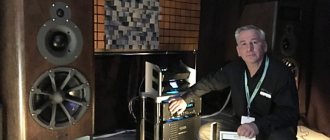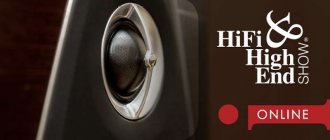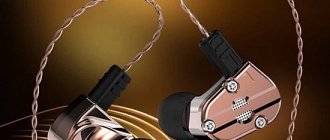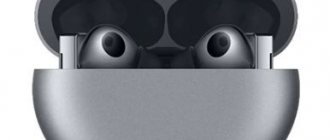The world of vinyl records
The highlight of the exhibition is the vinyl record fair, which brought together admirers of the old warm sound. Under the roof of the exhibition hall there were several sellers, both with new and old vinyl. The reigning atmosphere of antiques makes one only envy the collectors who rummage through the boxes in search of that very record.
Many stands are dedicated to tube sound; all equipment can be listened to and evaluated. The specific placement of the exhibition in hotel rooms made it possible to achieve an unprecedented naturalness of the demonstration. It is enough to enter any room, sit in a chair and simply enjoy listening to the equipment, which is installed as if you were in an ordinary living room.
Report from the Hi-Fi & High End Show 2022: such different Hi-Fi (part one)
The largest Russian exhibition of good audio (and not only) equipment has died down. They showed everything there, we even showed ourselves live. And the technicians there showed a lot of sonorous and not very, expensive and not very, beautiful and not very, tube and not very... What can I say, we begin our report in four parts. And for those who have also been there, we invite you to leave your impressions in the comments.
Part 2: Projectors, Headphones and Game Room
Part 3: Different highends are needed
Part 4: Audio technology and its listeners
In one of the HomeSound rooms, one could listen to the Acoustic Energy 300 series speakers, which replaced the 3 series. The 309 floorstanders were installed next to last year's 109s, and they could be compared head-to-head. The new speakers have rounded edges and are slightly larger than their predecessors. With the Creek amplifier, however, it was the 109s that sounded better - their stage turned out to be collected, but the 309s, despite the obvious potential in terms of dynamics and range, did not evoke a feeling of completeness of the system.
However, in the rooms of the Aquarium Hotel, few people managed to make the acoustics play well by placing them along the window. It will be interesting to listen to these speakers in more familiar conditions. Especially considering the fact that this model will be delivered already filled with ballast and weighs 22 kg. A body with a cavity for filling will not surprise anyone, but this is the first time the manufacturer has decided to take on this concern.
Prices for floor and shelf units are approximately 100,000 and 50,000 rubles, respectively, with slight deviations from the indicated figures depending on the finish.
At the Audiomania exposition, three-way rackmount speakers (designed to be placed on stands) Old School Classic One HS, priced at about 350,000 rubles, were paired with an Octave V80SE tube amplifier. The source in the system was a Pro-Ject 6 Perspex SB turntable with an MC head connected to an Octave Phono Module preamplifier. The total cost of the components exceeds a million rubles.
The walls of the Classic One HS case are assembled from a sandwich consisting of two layers of MDF and a special polymer, and the speakers are used with high efficiency. Thanks to a sensitivity of 91 dB, the sound was peppy and dynamic, but, for my taste, too “old school”, with an overly emphasized midrange.
There was no particular coloration, but the noticeable directionality, combined with the crampedness of the hotel room, gave a lot of reflections, which did not benefit the system. Audiomania solved this issue in a radical way by organizing a “continuation of inspection” in its salon.
In the next room I found more affordable solutions from the same company. For example, Arslab Studio 10. This stereo pair costs less than 30,000 rubles. Each speaker weighs 7 kg and has a sensitivity of 88 dB. Heavily damped thick-walled acoustics create a stable stereo stage almost everywhere - both in a hotel room and in the Audiomania showroom (more details in our report).
Arslab Classic Sat W bookshelf speakers for 34,000 rubles were also demonstrated there. The name and flat body indicate that their main purpose is the rear of a home theater. But they can also work as part of a trifonic, and even as a shelf pair if the room is small.
Sonos Playbase appeared in Russia last fall, so Hi-Fi & High End Show 2022 became the first exhibition at which this product was seen by a wide audience. In the distributor's room, it played three roles: in the triphonic system, as an independent device, and in a full-fledged 5.1 cinema system (except for its built-in subwoofer). I was most impressed by the performance of the Playbase in cinema instead of two front speakers and a center one. Despite the asymmetrical configuration of the room and the presence of heterogeneous reflective and sound-absorbing surfaces, the surrounding sound field was smooth and seamless; all the components of the soundtrack were heard from where you expected them. This “soundbar” costs 68,000 rubles, but do not forget that this is a full-fledged participant in the Sonos multi-room system, hence the quotes.
In the third floor foyer, Wharfedale Diamond 11.4 floorstanders were driven by a Quad Artera Stereo power amplifier fed from an Artera Play preamp/turntable. The system played openly and dynamically, in accordance with the scale of the space that they had to voice. Moreover, the compromises that I wrote about in the Diamond test were not noticeable here at all.
This fact confirms the complaints of many participants about the unsuitable stereo acoustics of hotel rooms. It turns out that the speakers play well only after breaking free. On the other hand, this is a demonstration of the potential of these budget speakers, since the amplifier and source in total cost about 300,000 rubles.
In another foyer - on the second floor - you could listen to DALI Callisto wireless speakers. Their traditional proprietary ribbon tweeter is covered with a round mesh, so the configuration that has been proven over the years now evokes a feeling of novelty. But in fact, almost everything about this product is new, including the familiar-looking speakers, which have also been redesigned. The wall thickness has been increased to 25 mm.
Each speaker has a built-in 250-watt power amplifier, and you can use them simply as active speakers by connecting a preamp or other source with adjustable output to the line input. The DALI Sound Hub will gladly take on this role. It performs all the functions of a preamplifier, including a wireless connection at 5.8 GHz. The signal is transmitted without compression, in 24 bit/96 kHz format. To connect to the Internet and home network, the hub has a Wi-Fi adapter, and it is better to control it yourself using the BluOS Controller application. To do this, the Bluesound module must be installed in the Sound Hub.
Since with it the system acquires a number of useful functions, such as multiroom and streaming playback from multiple sources, the Russian distributor decided to supply a device already equipped with the module to our market. It will cost 100,000 rubles. A pair of floor-standing speakers costs 269,000 rubles, bookshelf speakers - 209,000 rubles. They differ from the older ones in the lower limit frequency, dimensions and they have one less bass speaker. Otherwise, the Callisto 2 C is almost identical to the floor-standing 6 C, even their amplifiers are the same. The hub is controlled not only from the application (there is also a remote control), and the volume can also be adjusted on the speakers themselves - for this purpose, there is a touch panel on the upper edge of the body of each of them. The set level is displayed by a line of LEDs. Visitors really enjoyed this attraction.
Ruark Audio was founded in 1986 and has been manufacturing traditional speakers for twenty years. But after the commercial success of the R1 receiver, the company completely switched to lifestyle solutions. In the hall of the fifth floor there is an exhibition of stylish music systems - from compact Bluetooth speakers to the so-called R7 audio console with support for multiroom, streaming, multi-format CD player and Bluetooth aptX HD. Her appearance reminded me of radios from the 70s of the last century, although she played quite modernly and fully.
In terms of size/sound ratio, the R4 model is most memorable. This compact 2.1 system caused sincere surprise among many visitors, who noted the mature and voluminous performance for such a baby. It’s a pity, it doesn’t support streaming, and it refused to play my flash drives that I brought with me. But the younger model R2 had no problems with them. But a pair of full-range speakers without woofer support no longer dared to claim the attention of audiophiles.
Emotiva Airmotiv T2 floorstanders, priced at 106,000 rubles, worked in conjunction with components from the same company. Based on the first impression, we can say that the advertising phrases about the availability of high-quality sound in the case of Emotiva can be considered fair: the system played smoothly and excitingly, the only remark is that the localization of stereo images was accurate in a rather narrow listening area. This is most likely a result of the directional nature of the ribbon tweeter. They were located parallel to the window, so we can talk about the relative ease of installation of these speakers. However, bass traps were seen in the corners of the room. With the lower limit frequency of the speakers being 35 Hz, they clearly did not interfere, since there was a feeling that the Emotiva produced as many low frequencies as there were in the phonogram. The shelf occupants were not so impressed - they probably needed either a smaller room or fewer early reflections. Something like a desktop version.
At the Simple Distribution stand, dedicated to Jamo acoustics, one could get acquainted with an unusual and elegant design solution. The standard Studio 8 series floorstanding speakers are designed for home theater use and feature up-firing speaker terminals. This connection is made through terminals on the top panel, which also serve as clamps for the “high-rise” modules. Magnetic protective grids are made in the same style and create uniformity, covering all radiating surfaces. A kind of Lego construction set for Dolby Atmos - patented, by the way.
The KEF LS50 Wireless speakers for 150,000 rubles, demonstrated in the MMS room, essentially represent a complete music system. They don’t need any hub or source; a smartphone with the application of the same name installed is enough. By connecting them to the router, you can start listening to music from various Internet services, such as Tidal, or playing files from your home network using the DLNA protocol. Of course, standard connection options, from analog to USB, were not neglected.
In terms of sound character, they are very reminiscent of their ancestors - the original LS50, but separate amplification by bands gives greater control over the speakers, and, as a result, some authoritarianism, which many will like. On the other hand, the presence of high-tech filling stole the lightness characteristic of the passive version. But I managed to send a couple of familiar tracks to them from my phone (both from the KEF LS50 Wireless’s own application and from the universal Hi-Fi Cast player), which immediately appeared in the list of available playback devices on KEF.
Part 2: Projectors, Headphones and Game Room
Part 3: Different highends are needed
Part 4: Audio technology and its listeners
Digital Age
Vinyl and tube amplifiers are a nod to the past, today the mass market is concentrated around digital equipment, with special attention paid to portability. Yes, at a joint stand KOSS And Soul it was possible to evaluate any of the presented models both with its own player and with the help of a Hi-Fi player supplemented with an amplifier. We refreshed emotions from already familiar models: Porta Pro, GMR-540-ISO and BT539i. But the main discovery of the stand was ESP-950, which combine lightness and unbridled breadth of sound. The first impression is that the sound does not come from headphones at all, but professional equipment is installed in the room, complete immersion in music is guaranteed! Soul, in turn, presented several pairs of wired and wireless headphones in a youthful design. None of them aroused any particular interest from a sound point of view.
At the Sennheiser the M2 AEBT , HD 4.50 and PXC 550 Wireless headphones . All models have a closed design, are equipped with NFC for fast connection and support the aptX codec. Another feature is the NoiseGard , which is combined with wrap-around ear pads. The main difference between them is the quality of the speakers; in addition, the design, controls and cost differ. Also, the company did not forget about Hi-Fi sound; at the corresponding stand one could get acquainted with the flagships of the line, for example, HD 599 and HD 800 . The headphones were created for playing music at home, so the pair used Japanese Hi-End equipment Melco . Although some kits required connecting your own equipment, next time we’ll take an AUX cable and a portable Hi-Fi player.
The stand with armature and hybrid in-ear headphones was presented by three brands: Campfire Audio , Westone and Etymotic . The latter, represented by ER4SR, took part in the test and left an extremely positive impression. At the demo stand, each model was available paired with Hi-Fi players of different models.
FiiO surprised us with a rich selection of portable Hi-Fi sources; at the stand there were players and amplifiers for every taste. We were interested in the portable amplifier FiiO Q1 II . A small aluminum box turns any smartphone into a serious Hi-Fi player that can handle any headphones. Moreover, the dimensions of the device are comparable to the same smartphone, and the weight is only 101 grams. Another interesting device is the FiiO BTR1 , which turns any headphones into wireless ones. Support for the aptX codec will ensure the highest possible quality for a wireless connection.
At the HiFiMAN , visitors were presented with the EF2C , which is equipped with 6J1 tubes for truly warm sound in the digital era. You can pair any brand headphones with the amplifier. Edition X attracted our attention , first of all, with its design. Also interesting are the isodynamic emitters promoted by the HiFiMAN . Instead of a conventional electromagnet, the field in such emitters is created by two gratings, between which a membrane is stretched. Technology was at the origins of the development of Hi-End audio equipment. There is only one impression - this combination of a tube amplifier and isodynamic headphones needs to be heard with your own ears!








